![]()
![]()
![]()
Use LEFT and RIGHT arrow keys to navigate between flashcards;
Use UP and DOWN arrow keys to flip the card;
H to show hint;
A reads text to speech;
23 Cards in this Set
- Front
- Back
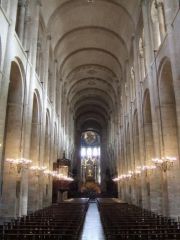
|
Romanesque
Interior St. Sernin Cathedral c. 1070-1120 (barrel vault--must be Romanesque) (round arches, ribs) |
|
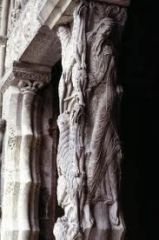
|
Romanesque
Prophet Jeremiah and lions trumeaux Moissac c. 1115-1130 (Romanesque: Flattened, stylized, elongated figures, Old Testament subject matter) |
|
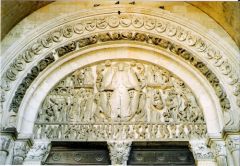
|
Romanesque
Gislebertus tympanum St. Lazare c. 1120-1135 (Gislebertus made me: patron? Christ in Majesty, Last Judgement scene with the dead pulled up for judgement. Good go to heaven; Sinners pushed into mouth of hell.) (How can you tell it is Romanesque? Flattened, stylized figures) |
|
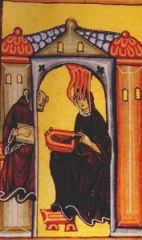
|
Romanesque
Hildegarde von Bingen receiving visions 1150-1179 (Famous Abbess; shared visions and insights with Aristocrats and Pope, scribes wrote them down, composed divine music, shows visions flowing into her head.) |
|

|
Romanesque
Head Reliquary of St. Alexander 1145 (Pilgrimage churches needed reliquaries. Relics of saints and religious figures could be "liberated." Adorned with sacred gold and jewels: divine light) |
|
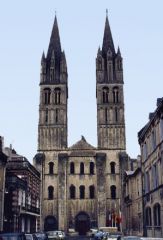
|
Romanesque
St. Etienne, Caen, France c. 1115-1120 (Rational facade mirrors interior organization) (How can you tell it is Romanesque? Round arches, simple facade compared to Gothic) |
|
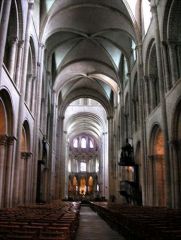
|
Romanesque
Interior St. Etienne, Caen, France c. 1115-1120 (How can you tell it is Romanesque? Count the ribs in a vault. 6 ribs = Sexpartite vaults that span two bays--it must be Romanesque) |
|
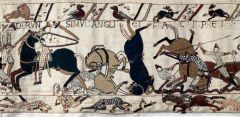
|
Romanesque Bayeux Tapestry,
1070-1080 (Records Norman invasion of England and William's victory over Harold. Embroidered, not true woven tapestry. Probably created to wrap around the inside of a hall for Bishop Odo, William's cousin. Legitimates conquest. Dynamic chronicle, somewhat cryptic.) |
|
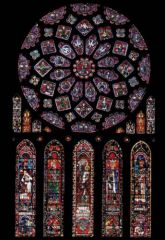
|
Gothic,
Chartres North Transept Rose Window and Lancets, c. 1220 (Marian symbolism often found on North side, Marian imagery also about Christ's lineage: tree of Jesse; divine light of God.) (How can you tell that it is Gothic? Lots of stained glass and pointed arches) |
|
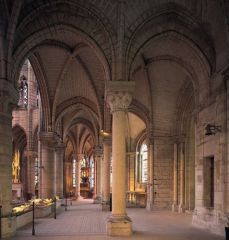
|
c. 1140-1144
Gothic Abbott Suger (St. Denis ambulatory and radiating chapels, chapels open up into apse; transition to Gothic: walls replaced by columns and piers, allowing curtain wall windows. Vaults have complex ribbing to accomodate apse curve. Windows are for Lux Nova, neoplatonic theory) (How can you tell it is Gothic? It has lots of light with columns instead of piers in the apse to let light into the altar from the big windows) |
|
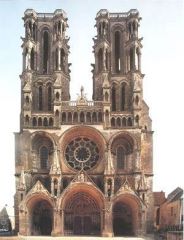
|
Gothic Laon Cathedral, c. 1190
(How can you tell it is Gothic? Rose window stained glass, triangles over the entrances, elaborate decorations.) (How can you tell it Laon and not some other Gothic cathedral? The facade is not super elaborate so that tells you it is early Gothic, but it is the bell towers that really show it--they are diagonal to the facade and they have oxen sticking off--those little poky bits that stick off the sides of the tower--those are oxen. It is less elaborate than Reims, which also has diagonal towers) |
|
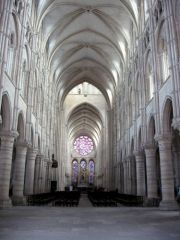
|
Gothic, interior Laon Cathedral, c. 1190
(How can you tell this is Gothic? Pointed arches. How can you tell this is Laon? It has columns in the nave instead of piers. So, do a check for columns so that you can eliminate some churches from your possibilities file) |
|
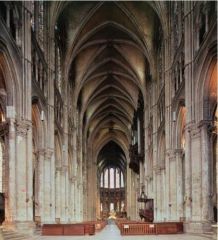
|
Gothic
vaults Chartres Cathedral c. 1194 (How can you tell this is Gothic? Pointed arches. How can you tell it is Chartres: more stained glass --see it in side aisles and clerestory. Contains triforium level above Nave with clerestory above--allowed for more window surfaces.) |
|
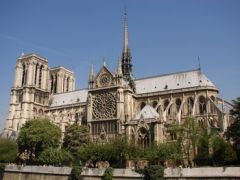
|
Gothic Notre
Dame Cathedral Paris c. 1180-1200 (elevation changed, allowing more direct light, flying buttresses in choir allow in more light; rose windows replaced) |
|

|
Gothic
vaults Amiens Cathedral, c. 1220 (How can you tell it is Gothic? Pointed arches. Hoe can you tell that it is Amiens? 4-part vaults. Count the ribs. Highest Gothic vaults, 138 feet high. Heavenly New Jerusalem on earth.) |
|
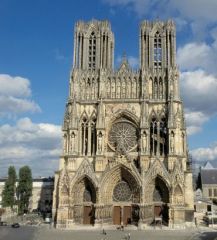
|
Gothic
facade Reims Cathedral, c. 1225-1290 (How can you tell it is Gothic? It has pointed triangles over the entrance and it is really elaborately decorated. How can you tell it is Reims? Towers are turned on the diagonal and they are more fancily decorated than Laon--and shorter!) |
|

|
Gothic
Annunciation and Visitation sculpture, facade of Reims Cathedral, c. 1230-1255 (How can you tell it is Gothic? Naturalistic, classical style figures. Two sets of sculpture: Annuciation earlier, more simplified. visitiation strongly reflects Greco Roman tradition--seen in crusades and Roman ruins. Gothic S curves indicate movement, recall contrapposto, draper folds more naturalistic.) |
|

|
Gothic
Interior Ste. Chapelle, 1243-1248 (How can you tell it is Gothic? Walls entirely glass with small piers in this small building. How can you tell it is Rayonant? All windows. Meant to hold many different relics gathered by King Louis in the Crusades, it was like a reliquary, itself, filled with God's light. Height of fashion.) |
|
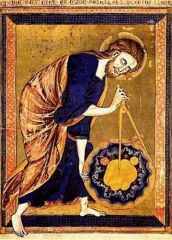
|
Gothic
God as Architect manuscript page, 1220-1230 (Ottonian/Byzantine influence, God likened to a cathedral builder.) |
|
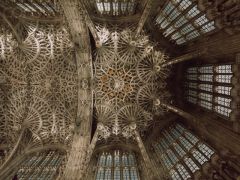
|
Gothic
Robert and WIlliam Vertue, fan vaults, Chapel of Henry VII, Westminster Abbey |
|
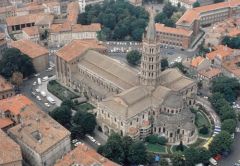
|
Romanesque
St. Sernin Cathedral c. 1070-1120 (How can you tell it is Romanesque? Huge, round arches. Barrel vaults, ribs, ambulatory, radiating chapels, crossing tower, transept) |
|
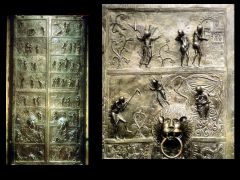
|
Ottonian Bronze Doors St. Michael’s, Hildesheim
1015 (First large scale bronze casting since the end of the Roman empire in the west; relief, scenes from the life of Christ paired with Old Testament scenes that show the Fall of Man paired with Redemption of Man scenes from the events in the New Testament.) |
|
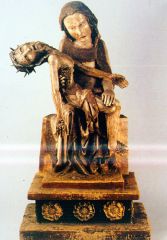
|
Gothic
Rottgen Pieta, German, c. 1300-1325 (Intensely horrific and emotional, meant to evoke pity and remorse for sin. New, German emotional power.) |

